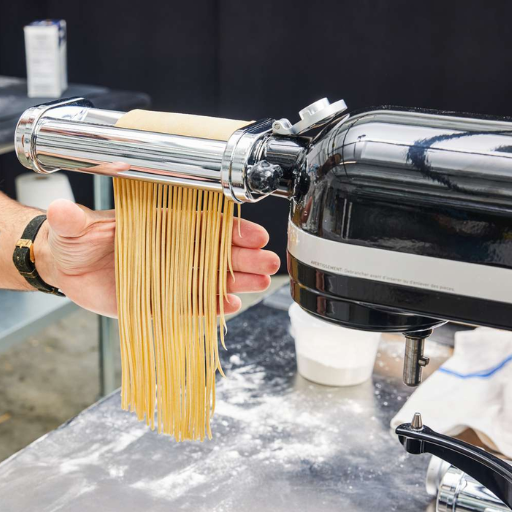In the world of cooking, few dishes bring people as much joy and satisfaction as a plate of well-made pasta. Whether you are a professional or an amateur chef, having the appropriate pasta maker can significantly enhance your overall cooking journey. Many options are available, from classic manual pasta makers that provide hands-on, artisanal precision to modern electric machines that offer efficiency and convenience. This article presents the top five pasta makers in 2024 that cater to different preferences and needs, thus helping you find the perfect addition to your kitchen. Come along with us as we delve into the features, benefits, and unique attributes of each best-rated pasta machine to ensure that all decisions are based on facts during our adventure into making different types of pasta!
How do I Choose the Best Pasta Maker for My Needs?
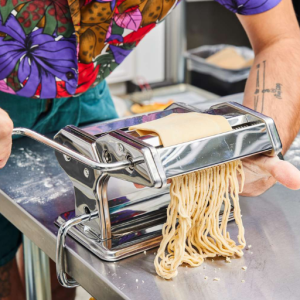
Image source: https://www.thespruceeats.com/
There are several key factors to consider when selecting the best pasta maker: your level of experience, the type of pasta you want to make, and the setup in your kitchen. Beginners or people looking for convenience may choose an electric pasta maker that mixes and extrudes dough and food. However, traditionalists or those who prefer a hands-on approach might go with manual machines because it gives them more control over their product and allows for customization. Other things to think about would be capacity, ease-of-cleaning, versatility in making different pasta shapes such as spaghetti vs. fettuccine, etcetera, overall build quality, etcetera (again). It is also helpful to read what other users have said about this product before deciding which one will work best for them. According to user reviews, it can be very informative and expert recommendations.
What Features Should I Look for in a Pasta Maker Machine?
When you are looking for a pasta machine, keep these features in mind:
- Ease of Use: If you are new to making pasta, look for something easy. Electric machines have automatic settings, while manual ones should have handles that turn quickly.
- Material Quality: Pasta makers should be made of materials like stainless steel because they last longer and consistently perform better.
- Versatility: A good pasta machine will allow attachments or settings to make different shapes and sizes. This means you can try out all sorts of pasta!
- Cleaning Ease: It’s best if the machine can be taken apart quickly and has parts that are dishwasher safe. This makes cleaning up much more accessible.
- Capacity: Think about how much pasta you plan on making at once. Some machines can handle more dough than others, so pick one that matches your cooking style.
- Price and Warranty: Is the price right for your budget? Also, check if there’s a warranty included with the purchase, as it shows confidence from the manufacturer in their products’ durability/performance.
With these features, one will find a perfect match to ensure a fun-filled and convenient time when making homemade spaghetti!
Why Should You Consider a Manual Pasta Maker?
Opting to use a manual pasta maker can have many advantages. To begin with, such devices usually offer better control over noodles’ thickness and texture, enabling one to achieve more personalized outcomes. Moreover, they are generally longer-lasting because they contain fewer electronic parts that may wear out quickly, thus ensuring durability and maintaining consistent performance throughout their lifespan. Additionally, these pasta-making machines tend to cost less than electric models, besides being environmentally friendly since no power supply is needed. Finally, rolling out dough manually could be an enjoyable therapeutic exercise for some people, giving homemade pasta a unique personal touch.
Is an Electric Pasta Maker Worth It?
Whether an electric pasta maker is worth the money will depend mainly on how and what you cook. These machines save a lot of time, from blending and kneading the dough to extruding the pasta. They are also easy to use and often come with many attachments that let you make various types of pasta with minimal effort.
Nevertheless, electric units generally cost more than their manual counterparts; hence, they need regular servicing to last long. Additionally, because electric models take up space on your kitchen counter and require a power supply (which might not be available everywhere), some argue that using them robs one of the tactile experiences associated with such activities as using a hand-held manual pasta machine.
In conclusion, if speediness matters most when making homemade macaroni products, then purchasing an electric device would make sense. However, if you appreciate tradition through touch, opt for manual methods instead.
What Are the Differences Between Manual and Electric Pasta Makers?
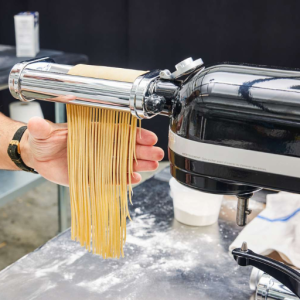
You will find several notable differences when comparing manual pasta makers with electric ones. For example, while manual machines require one to exert physical force to roll and cut dough, thus giving them a hands-on traditional feeling and better control over the thickness and texture of pasta, they are generally cheaper, smaller, and do not require electricity.
On the other hand, electric models automate much of this process by mixing and kneading dough before extruding it into different spaghetti shapes. This saves time considerably while producing consistently good results every time—an ideal choice for those who make pasta frequently or in large quantities. Nonetheless, they initially cost more, need regular servicing intervals (maintenance), occupy larger counter spaces, and depend on the power supply from the main sockets.
In summary, choosing a manual or electrical device depends on convenience versus traditionalism, cost implications, including repairs and initial purchase price tags, and personal preferences during pasta preparation.
Pros and Cons of a Manual Pasta Maker
Pros:
- Real Experience: Manual pasta makers create an old-fashioned, hands-on experience where you can control how the dough is rolled and cut. This enables you to put in some personal touch.
- Cost Effectiveness: Manual pasta makers are generally cheaper than electric ones, making them affordable for home cooks.
- Compact and Portable: They are usually smaller and do not require electricity. They can be stored easily or used in any kitchen space, even when traveling.
- Durability: Having fewer moving parts and being made from solid materials usually makes them last longer while working consistently over time.
Cons:
- Laborious: Using a manual pasta maker involves much physical effort, such as kneading, rolling, or cutting the dough, which takes time and energy, especially when dealing with large quantities.
- Steep Learning Curve: Compared to other methods, such as electricity-powered machines, beginners may need to get used to this pasta method.
- Inconsistency Of Outcome: Getting even thicknesses throughout all pieces may prove difficult; hence, results might differ according to the skills employed, thus leading to a lack of uniformity in the final product achieved through manual pasta making.
-
Fewer Features: Hand-operated models offer less variety in shapes or sizes, unlike those powered electronically, with more options for different kinds of pasta.
Advantages of Using an Electric Pasta Machine
- Efficiency: An electric pasta machine does the kneading, rolling, and cutting for you, so you don’t have to spend as much time or effort making fresh pasta.
- Evenness: With these machines, each batch will have the same thickness and texture no matter your skill level—they produce consistent quality every time.
- Variety: Most electric pasta machines have different attachments and settings, making making noodles of all shapes and sizes easy.
- Rapidity: By automating this process, lots of pasta can be produced quickly, making it suitable for large gatherings or meal preps.
-
Ease of use: Electric-powered noodle makers are user-friendly, providing simple instructions and requiring less manual intervention, making them suitable for beginners.
Which Type is Best for Homemade Pasta?
Using a manual or electric pasta maker when making homemade pasta depends on what you want. You don’t have to take my word for it; this is according to leading sources in the industry. They say nothing beats a manual pasta maker if you enjoy being hands-on with your cooking and prefer things done the old-fashioned way. Manual ones are also cheaper than their electric counterparts but just as durable as they are made of stainless steel with adjustable rollers so that you can control how thick or thin your dough gets.
Electric pasta machines are considered by many experts the most convenient and efficient way of making noodles because all they require from users is pushing buttons, after which these gadgets do everything else automatically, saving time, especially when dealing with large quantities while still producing high-quality results consistently every single time thanks to its powerful motorized mixing paddle system which evenly mixes ingredients before kneading them into dough ready for extrusion through different shaped dies resulting in perfectly cooked al dente pasta such as spaghetti tagliatelle fettuccine macaroni lasagna sheets etcetera within minutes only.
In conclusion, if you love working meticulously on crafts like handmade pasta, go for an old-fashioned Italian-style hand crank roller type machine, but if speed matters more than anything else, then opt for one of those modern automatic electrically operated models.
Top Models: Which Pasta Maker Brands Are the Best?
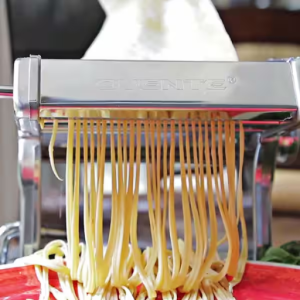
Many top pasta maker brands are recognized for their quality, durability, and user-friendly designs. Marcato Atlas is often recommended among manual pasta machines as it has a robust construction. Its electric models have been regarded as one of the best in the market. Philips is a favorite brand because they make innovative and efficient pasta makers that streamline everything for you. Another good brand is Imperia, which offers both manual and electric options that perform well and are reliable. KitchenAid also makes versatile pasta-making attachments, which can be used with different types of mixers, so this is another popular choice among people who love making fresh noodles at home frequently or occasionally, depending on their mood or appetite level. In conclusion, these companies produce high-quality appliances catering to various needs while maintaining good value for money among customers who want nothing short of excellence in kitchen gadgets like these!
Exploring the Marcato Atlas 150 Pasta Machine
Many top pasta maker brands are recognized for their quality, durability, and user-friendly designs. Marcato Atlas is often recommended among manual pasta machines as it has a robust construction. Its electric models have been regarded as one of the best in the market. Philips is a favorite brand because they make innovative and efficient pasta makers that streamline everything for you. Another good brand is Imperia, which offers both manual and electric options that perform well and are reliable. KitchenAid also makes versatile pasta-making attachments, which can be used with different types of mixers, so this is another popular choice among people who love making fresh noodles at home frequently or occasionally, depending on their mood or appetite level. In conclusion, these companies produce high-quality appliances catering to various needs while maintaining good value for money among customers who want nothing short of excellence regarding kitchen gadgets like these.
Review of the Philips Pasta Maker
People love the Philips Pasta Maker because it can make fresh pasta without much work. It is a machine that does all the job after you put in the ingredients; it mixes, kneads, and extrudes the dough in less than 10 minutes. There are different shaping discs for spaghetti, penne, lasagna, and more. Most reviewers say this product is straightforward to use, operates quickly, and gives consistent results every time, making it perfect for people who don’t have much time or just love pasta. The storage compartment for cleaning tools and discs is built into the machine, so it’s easy to keep everything together and not lose anything; plus, its small size means it will fit anywhere in your kitchen without taking up too much space. In conclusion, I recommend buying this efficient device if you want reliability and versatility from a brand like Philips, which has always been known for quality products at affordable prices – now, even making homemade noodles can become part of your daily routine.
Why the Kitchenaid Pasta Roller Attachment is Popular
Because of its sturdy design and ease of use, the Kitchenaid Pasta Roller Attachment is a big hit. This accessory works perfectly with any model Kitchenaid stand mixer by taking advantage of the high power of the mixer to roll out pasta dough quickly and uniformly. Users love that it has rollers made from stainless steel, which are good quality and ensure smooth pasta sheets every time. Another thing this attachment has going for is how much time you can save using one instead of doing everything by hand; these devices can pump them out quickly! For different types thickness levels there are settings on this versatile rolling tool such as lasagna sheets or fettuccine noodles etcetera– reviewers rave about how convenient they are to clean up after too (and that they last forever). In summary, performance is unmatched, and craftsmanship and top-notch user-friendly features galore – what else could we ask for in our kitchen arsenal?
How to Use a Pasta-Making Machine?
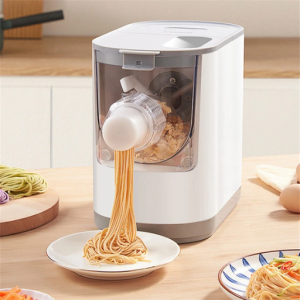
Using a pasta-making machine is simple and can be broken down into a few basic steps:
- Make the Dough: Mix your pasta dough with your favorite recipe. The dough should be smooth and elastic.
- Divide and Flatten: Cut the dough into more manageable pieces, then flatten each piece with your hands to fit through the machine.
- Set Thickness: Change to the widest setting on your machine and pass the dough through the rollers. Repeat several times, decreasing the thickness until you reach the desired thickness.
- Cut Pasta: When the dough has reached the appropriate thinness, switch to the cutting attachment if available on your particular model. Feed the sheet through to cut noodles, spaghetti shapes, etc.
- Dry Pasta: Spread the cut pasta onto a drying rack or clean surface dusted lightly with flour so it doesn’t stick together.
- Cook or Store: Boil for cooking immediately or store away for later use.
By following these directions, one should be able to produce fresh homemade pasta using a pasta-making machine successfully.
Step-by-Step Guide to Making Pasta with a Manual Machine
Making pasta with a manual machine is a rewarding process that can be done in several steps:
- Prepare Your Workspace: Clear a clean, flat workspace and gather flour, eggs, and your manual pasta machine.
- Mix the Dough: Mix 2 cups of flour with three large eggs until dough forms. Knead until smooth and elastic for about 8-10 minutes.
- Rest the Dough: Let the dough rest wrapped in plastic for 30 minutes to relax the gluten.
- Divide and Flatten the Dough: Split the dough into smaller portions, then flatten each piece enough to fit through the widest setting of your pasta machine by hand.
- Roll the Dough: Feed the dough through rollers on the widest setting. Fold it in half, then repeat this process a few times to smooth and stretch it.
- Thin the Dough: Gradually make rollers closer together by adjusting settings on the machine; feed dough through each thinner setting as you go until the desired thickness is reached, then roll through without folding for the final pass.
- Cut the Pasta: Use a cutting accessory or knife to slice sheets into the preferred shape.
- Dry the Pasta: Lay cut pasta on a drying rack or floured surface to prevent sticking. If storing, slightly dry it, but cook immediately otherwise.
- Cook the Pasta: Boil water with a pinch of salt before adding fresh pasta. It should be cooked for 2-3 minutes until tender since it cooks faster than dried pasta.
Tips for Using an Electric Pasta Maker
- Read the Manual: Before using your electric pasta maker, thoroughly read the instruction manual to familiarize yourself with its features, settings, and safety guidelines. Each model may have specific operating instructions.
- Prepare Ingredients Properly: Use high-quality flour and fresh eggs to ensure the best results. Measure your ingredients accurately and consider using a kitchen scale for precision.
- Consistent Dough Texture: Ensure your dough is consistent—not too dry or too wet. It should be firm but pliable. If the dough is too moist, dust it with flour; if it is too dry, add some water.
- Pre-Cut Dough Pieces: Divide your dough into smaller, manageable portions before feeding it into the machine. This helps prevent overworking the machine and ensures even processing.
- Use the Right Attachments: Electric pasta makers have multiple attachments for different pasta shapes. Make sure to use the correct attachment for the pasta you make.
- Avoid Overloading the Machine: Feed the dough into the machine gradually and avoid overloading it. This helps maintain the machine’s efficiency and longevity.
- Clean Immediately After Use: Clean the machine immediately to prevent the dough from drying and sticking to the components. Follow the cleaning instructions provided in the manual, and avoid using water on non-detachable parts to prevent damage.
- Store Properly: When not in use, keep your pasta maker in a dry, cool place, and ensure all parts are dry before storage to prevent rust and damage.
By following these tips, you’ll master the use of your electric pasta maker and create perfect pasta every time.
Common Mistakes to Avoid When Using a Pasta Machine
- Using Incorrect Flour: A typical error is when people use general-purpose flour instead of semolina or ’00’ flour with high protein content. The latter offers better pasta texture and consistency.
- Going too hard on the Dough: If you knead the dough for more extended periods or keep passing it through the machine too many times, it becomes rubbery. You should only work the dough enough to make it elastic and smooth.
-
Neglecting Resting Time: Resting the dough is very important; it must sit for at least 30 minutes before rolling. Failure to follow this step results in sticky dough, which results in pasta without desirable chewiness.
What Accessories and Attachments Enhance the Pasta-Making Experience?
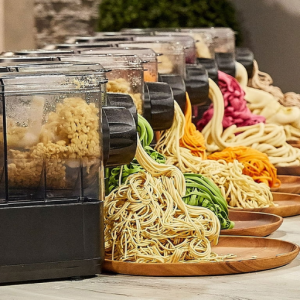
The pasta-making experience can be significantly improved with accessories and attachments, adding versatility and convenience. Some of the standard attachments include:
- Pasta cutter attachments: These are available in different sizes and shapes, such as fettuccine, spaghetti, or lasagna cutters, and can easily create multiple types of pasta.
- Ravioli makers: A specialized attachment or mold shapes and seals ravioli, ensuring uniformity in shape and size throughout all batches.
- Pasta drying racks: A must-have if you are making fresh pasta as it prevents sticking together while allowing even drying.
- Rolling pins: People who prefer rolling their dough manually before feeding into the machine will find adjustable thickness settings on a rolling pin very handy.
- Motor attachment: This could be used when automating the process only for those with manual machines, thus reducing the physical effort needed during the rolling phase.
These accessories /attachments will help you save time during the preparation stage and allow you to make various types of pasta.
Using a Pasta Roller and Cutter
To be successful in the utilization of a pasta roller and cutter, these steps should be followed:
- Dough Preparation: Knead the dough until well mixed and let it rest for at least half an hour to ensure a good texture.
- Machine Set-Up: Fasten the pasta roller onto the table or countertop. Start on the widest setting of your choice.
- Rolling the Dough: Take a rolling pin and flatten the disk-shaped dough, then run it through a roller at its widest aperture. After this, fold it in half; repeat the same process while narrowing down each time until the desired thickness is achieved using different roller settings.
- Cutting the Pasta: Connect the pasta cutter to the machine itself. Feed the rolled-out dough into the cutter, which will produce even shapes like fettuccine or spaghetti.
- Drying Pasta: If necessary, employ a pasta drying rack; otherwise, place cut pieces on a floured surface to avoid sticking together before cooking them later.
By following these steps systematically, anyone with access to a machine capable of rolling and cutting noodles from scratch—such as those found commonly in restaurants around town—can produce top-notch culinary delights at home using just a few basic utensils like this pasta maker combo set.
Benefits of the Pasta Maker Attachment for Kitchenaid Stand Mixers
For several reasons, the pasta maker accessory for Kitchenaid stand mixers is an excellent investment.
- Time-Saving Efficiency: This tool lets you roll out and cut pasta dough faster than manual methods.
- Consistent Results: By controlling the thickness and width of cuts more precisely, you can ensure that your noodles cook evenly every time.
- Versatility: Usually equipped with different rollers and cutters, it allows making various types of pasta, such as spaghetti or fettuccine.
- Ease of Use: The attachment is easy to set up and operate even for beginners, as it is designed to fit seamlessly into any Kitchenaid stand mixer model.
- Durability: Made of high-quality materials, this product will last longer than most others on the market, thus providing years’ worth of reliable performance whenever needed during homemade pasta-making sessions.
- Enhanced Culinary Creativity: This add-on enables users to try out new flavor combinations while adjusting dishes according to their personal preferences once they have tasted them after being cooked using such an appliance.
These are just some of the many benefits of using a pasta maker attachment for Kitchenaid stand mixers. To sum up, convenience meets culinary creativity.
How to Make Different Pasta Shapes with Attachments
The Kitchenaid pasta maker attachment can be used to create different pasta shapes. Below is a brief guide:
- Spaghetti:
- Attachment Needed: Spaghetti cutter
- Steps: Roll the pasta dough using the roller attachment until it becomes thin enough. Feed this through your spaghetti cutter, which will result in long, thin strands of spaghetti.
- Fettuccine:
- Attachment Needed: Fettuccine cutter
- Steps: Roll out more pasta dough with your roller to make it thinner, then pass it under the fettuccine cutter to get wider, flat noodles.
- Lasagna Noodles:
- Attachment Needed: Roller attachment
- Steps: After rolling this dough into lasagna sheets at its thickest setting, cut them into lasagna noodles of any desired length.
- Pappardelle:
- Attachment Needed: Roller attachment and knife
- Steps: Roll out some more pasta dough, but only up to about 1/16-inch thickness. Using a knife, cut wide strips about an inch wide, making pappardelle.
- Ravioli:
- Attachment Needed: Roller attachment and ravioli maker
- Steps: Roll the pasta dough to your desired thickness using the roller attachment. Place one sheet onto your ravioli maker, then fill it with whatever you want before covering it with another sheet and pressing it firmly around the edges, thus sealing off each piece while forming these into various shapes like squares or circles, etcetera.
With the right attachments and following these steps, many kinds of pasta can easily be made at home, thus giving a flexible cooking experience.
Frequently Asked Questions (FAQs)
Q: What are the top factors when buying a pasta maker?
A: When buying a pasta maker, consider whether you prefer a manual or electric model, the durability of the materials (like stainless steel), the range of pasta types it can make (noodle maker, pasta press, etc.), and if it has adjustable thickness settings to control the thickness of your pasta sheets. Additionally, check if it includes accessories like a pasta cutter or roller noodles maker.
Q: What is the best manual pasta maker available in 2024?
A: The best manual pasta maker in 2024 is often regarded as the Marcato Atlas 150. This hand crank model is known for its durability, the variety of pasta types it can produce, and adjustable thickness settings. It’s a reliable choice for anyone making fresh pasta by hand.
Q: Which is the best electric pasta maker to buy in 2024?
A: The best electric pasta maker in 2024 is the Philips 7000 Series Pasta Maker. It’s praised for its ease of use, speed, and ability to create various pasta shapes. This model is incredibly convenient for those who prefer an automatic pasta-making process.
Q: Are there pasta maker attachments available for stand mixers?
A: Yes, many brands offer attachments to pasta makers for stand mixers. KitchenAid, for instance, has a highly-rated gourmet pasta press attachment and a roller set. These attachments can help you get the best pasta-making experience using your existing mixer.
Q: How do adjustable thickness settings improve my pasta-making?
A: Adjustable thickness settings allow you to control the thickness of your pasta sheets, which is crucial for creating different types of pasta, such as lasagna, fettuccine, or filled pasta, such as ravioli. This versatility helps you perfect your pasta recipe to match specific dishes.
Q: What features make a pasta maker deluxe set desirable?
A: A pasta maker deluxe set is desirable for its comprehensive range of tools and accessories. Typically, these sets include various pasta cutters, rollers, and sometimes even a pasta drying rack. Including multiple attachments enhances the versatility and convenience of making fresh pasta at home.
Q: Is there a significant difference between fresh pasta and dry pasta?
A: Yes, fresh pasta and dry pasta have distinct differences. Fresh pasta, made from fresh pasta dough, tends to have a softer texture and cooks faster, making it ideal for dishes with lighter sauces. Dry pasta, typically store-bought, has a firmer texture when cooked and a longer shelf life, making it suitable for heartier sauces and more extended storage.
Q: What are the benefits of using a stainless steel pasta maker?
A: Stainless steel pasta makers are valued for their durability and ease of cleaning. They are resistant to rust and corrosion, providing longevity and maintaining hygiene. Stainless steel rollers and cutters can help achieve consistent, high-quality pasta.
Q: Can a fresh pasta dough recipe affect pasta quality?
A: Absolutely. The ingredients and method used in your fresh pasta dough recipe can significantly influence the texture and flavor of your pasta. Using high-quality flour and the correct ratio of eggs to flour can result in a smoother, more elastic dough that’s easier to work with and gives superior results.
Q: What is the benefit of having a pasta drying rack?
A: A pasta drying rack is helpful for adequately drying freshly made pasta before cooking or storing. This helps prevent the pasta from sticking together and can extend its shelf life. It’s beneficial for shapes like fettuccine or spaghetti, which need to be separated and evenly dried.












